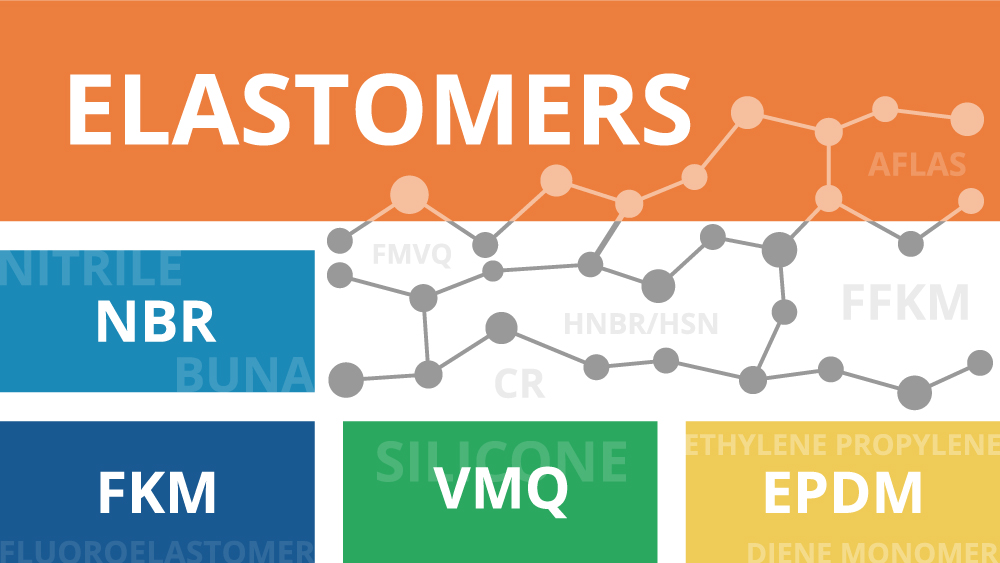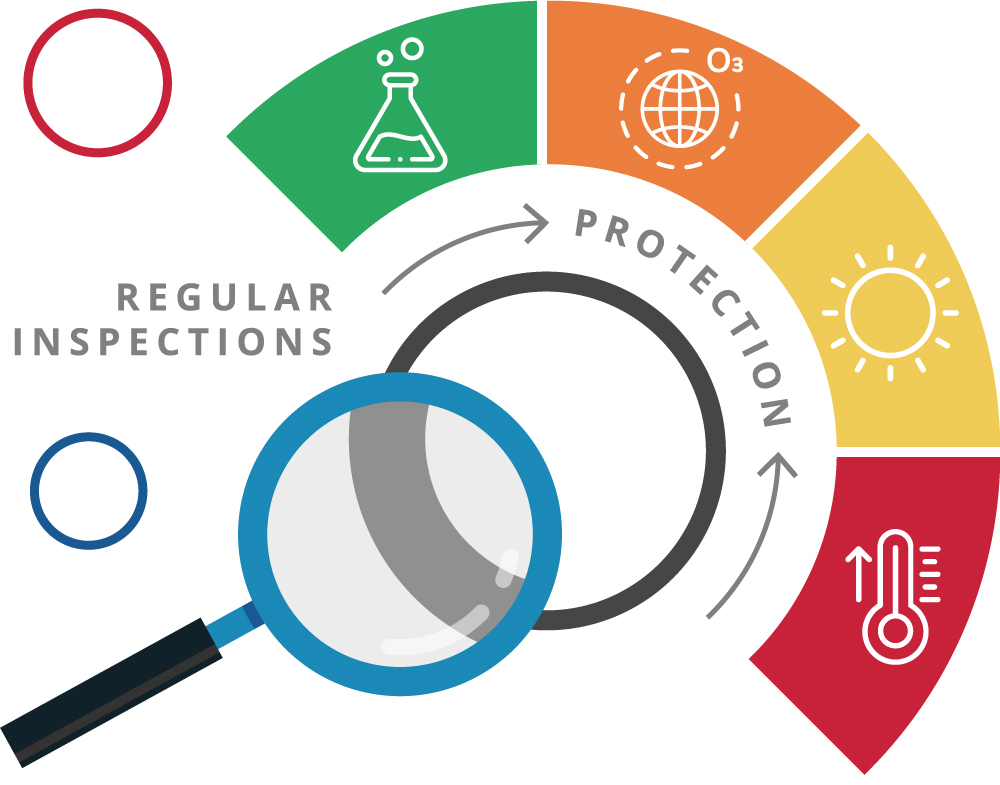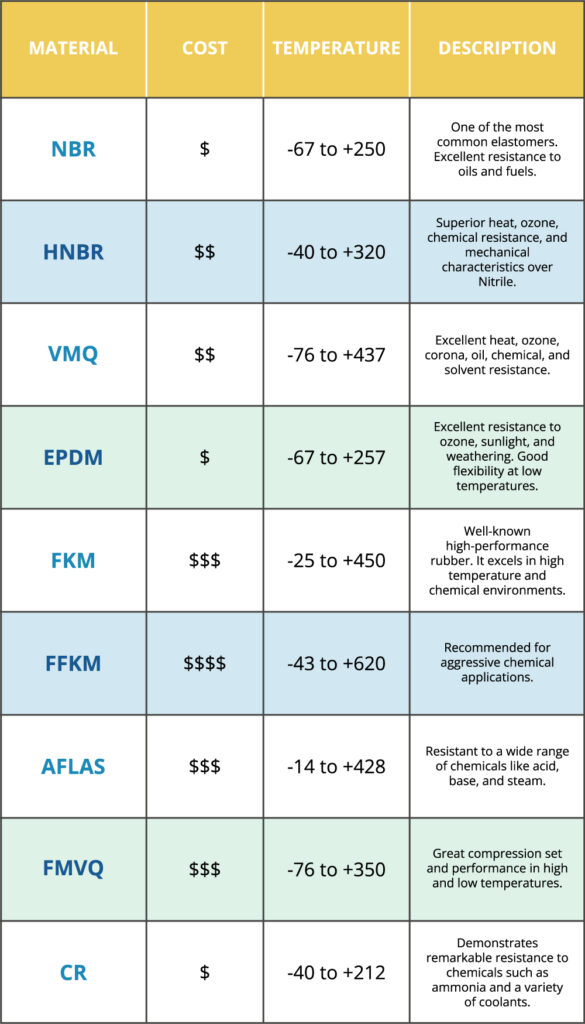
Summary
- Elastomers are highly elastic and flexible polymers used for o-rings, providing reliable sealing properties even in extreme environments.
- Common types of elastomers include Nitrile (NBR, Buna), Fluoroelastomer (FKM), Silicone (VMQ), and Ethylene Propylene Diene Monomer (EPDM), each with a unique set of characteristics and applications.
- Factors affecting elastomer performance include temperature range, chemical compatibility, and hardness, and proper maintenance and storage are essential for prolonging the lifespan of elastomer o-rings.
Overview
Elastomers are a class of polymers characterized by their unique properties of elasticity and flexibility. These materials have the remarkable ability to deform under pressure and return to their original shape when released. Elastomers exhibit resilience in extreme environments, maintaining their sealing properties and mechanical integrity even in the face of high temperatures, low temperatures, and harsh chemical exposures. These properties make elastomers highly suitable for o-rings, essential components for creating effective seals in various applications. O-Rings require materials that can withstand compression and form a reliable seal, preventing leakage of fluids or gases. Elastomers meet these requirements with their excellent elasticity, compression set resistance, and sealing capabilities, making them the preferred choice for o-ring applications. This blog post will explore the world of elastomers, discussing their types, properties, manufacturing processes, applications, and maintenance tips.
What are the Common Types of Elastomers?
Elastomers used in o-rings come in different varieties, each with its own set of properties and applications. The most common types include Nitrile (NBR), Fluoroelastomer (FKM), Silicone (VMQ), and Ethylene Propylene Diene Monomer (EPDM). Other options include Hydrogenated Nitrile or Highly Saturated Nitrile (HNBR/HSN), Perfluoroelastomer (FFKM), AFLAS®, Fluorosilicone (FMVQ), and Neoprene or Chloroprene (CR).
What Factors Affect Elastomer Performance?
Elastomers exhibit remarkable resilience in extreme environments, such as high temperatures, low temperatures, and harsh chemical exposures. They can maintain their sealing properties and mechanical integrity even under challenging conditions, making them versatile and reliable sealing materials. When selecting an o-ring, it is critical to consider the elastomer’s performance characteristics in three main categories: temperature range, chemical compatibility, and hardness.
Elastomers have specific temperature limits, and selecting the right material for the application’s temperature conditions is crucial. For instance, FKM resists extreme heat, while NBR performs well in moderate temperatures. For a list of each compound and their temperature ranges, go to our compounds page. Additionally, understanding the chemicals and fluids that elastomers can resist is essential. FKM, for example, exhibits excellent resistance to oils, fuels, and many chemicals. Check out our interactive chemical compatibility tool for more guidance on selecting an elastomer that will work best with different chemicals. Hardness, measured in durometer, affects an elastomer’s compression set and its ability to maintain a seal under pressure. Softer elastomers like silicone provide excellent sealing at low pressures, while harder materials like FKM are suitable for high-pressure environments. Read more about durometer on our “What is durometer?” page.
What are the Unique Properties of Elastomers?
Elastomers possess unique properties that make them ideal for o-ring applications. Their elasticity and flexibility allow them to deform under pressure and return to their original shape when released. This property ensures an effective seal and prevents leakage. In addition to their sealing capabilities, elastomers exhibit excellent resistance to compression set, maintaining their shape over extended periods. Tensile strength and elongation are also key factors to consider when evaluating elastomers. Higher tensile strength ensures greater durability and resistance to tearing, while elongation measures the material’s ability to stretch without breaking.
Notably, elastomers can be formulated and tailored to meet specific application requirements. By adjusting the composition, additives, and curing processes, elastomer properties such as hardness, chemical resistance, temperature range, and compression set can be customized to suit the intended use, offering greater design flexibility for engineers and manufacturers.
How are Elastomer O-Rings Manufactured?
Elastomer o-rings are manufactured using various techniques, including compression molding, injection molding, and extrusion. Compression molding involves placing a pre-measured elastomer compound into a mold and applying heat and pressure until it takes the desired shape. This method is suitable for producing o-rings in various sizes and materials. Injection molding injects the molten elastomer into a mold, allowing for complex shapes and high production rates. It is commonly used for large-scale production of o-rings. Extrusion produces continuous profiles of elastomers that can be cut into o-rings. This process is suitable for manufacturing o-rings with custom cross-sections or long lengths.
What are the Applications of Elastomers?
Elastomer o-rings find extensive use in diverse industries, including:
- Automotive: assist in sealing engine components, preventing fluid leaks and ensuring optimal performance.
- Aerospace: maintain seals in extreme temperatures and vacuum environments, ensuring the safety and reliability of critical systems.
- Oil and gas: prevent leaks in pipelines and equipment, safeguarding the environment and maintaining operational efficiency.
- Healthcare: used in medical devices, ensure sterile environments and prevent contamination in surgical instruments and fluid handling systems.
Elastomers, however, are not just used in o-rings. They find applications far beyond, with their versatility extending to gaskets, seals, hoses, conveyor belts, and countless other products in various industries. Also, elastomers are widely used in electronics, construction, food processing, and pharmaceuticals, highlighting their adaptability and importance in diverse sectors.
How Should Elastomers Be Maintained and Stored?

Proper maintenance and storage are essential to prolong the lifespan of elastomer o-rings. Regular inspections for wear, damage, or signs of degradation are recommended. O-Rings should be protected from excessive heat, sunlight, ozone, and harsh chemicals. Proper lubrication can also help reduce friction and extend the o-ring’s life. When storing o-rings, keeping them in a cool, dry place away from direct sunlight and chemicals that may cause deterioration is important. Using airtight containers or sealed bags can help maintain their quality. Click here for o-ring shelf life recommendations and more information on storage conditions.
Conclusion
Elastomers are the backbone of o-rings, offering exceptional sealing capabilities in various applications. By understanding the different types of elastomers, their properties, and the factors affecting their performance, you can make informed choices when selecting the right material for your specific needs. With proper maintenance and storage, elastomer o-rings can provide reliable sealing solutions, ensuring efficiency and durability in various industries. Global O-Ring and Seal is filled with an expert team that can provide you with guidance in selecting the best elastomer for your application. To get in touch, please fill out our contact form or give us a call at 832-400-9065. Already know what you’re looking for? Visit our online store and sort by the o-ring material to find the perfect o-ring.

 English
English  Español
Español  Français
Français  Português
Português  Deutsch
Deutsch  Italiano
Italiano  Русский
Русский  中文
中文  日本語
日本語  العربية
العربية  हिन्दी
हिन्दी 




